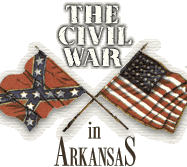
|
Arkansas was drawn into the Civil War in May, 1861, by its decision to secede from the Union. Troops were mustered and civilians devoted their energy and resources to providing food, clothing, weapons, and horses for the soldiers.
Two major battles, Pea Ridge and Prairie Grove, were fought in Arkansas. In 1863, the Confederate government moved to Washington in the southwestern corner of our state; and, in 1864, the Union government was established in Little Rock.
After the Civil War ended in 1865, the era called Reconstruction began, during which dramatic changes were made in the South. The Democrats returned to power in 1874, the same year our present constitution was adopted.


The scrappy border town of Fort Smith grew up slowly around the walls of a small fort established in late 1817 on a high bluff overlooking the junction of the Arkansas and Poteau rivers.
The site was familiar to hunters and trappers because it was the location for annual trade rendezvous' between frontiersmen and Native Americans. Named for General Thomas Smith at the federal garrison in St. Louis, the tiny outpost was originally built to promote peace between the warring Osage and Cherokee Indian tribes.
Because of its unique geographical position - straddling the border between what became the state of Arkansas and what was known then as "Indian Territory" in present-day Oklahoma - Fort Smith by the mid-19th century was feared as "Hell on the Border," the gateway between "civilization" and the untamed West.
Through this gate passed trappers canoeing upriver; Cherokee Indians on their fateful "Trail of Tears" journey; Forty-Niners seeking gold in California; the Butterfield stagecoaches linking St. Louis to Santa Fe; Confederate and Union troops skirmishing in the Civil War; outlaws seeking freedom across the border; and even cowboys and ranchers headed for Texas.
Today's Fort Smith still hustles and bustles in a different way. Over 80,000 folks call Fort Smith Home.
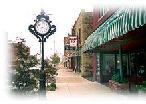
|
Downtown Fort Smith
Stretching from the shadow of the Oklahoma (U.S. 64) bridge east to 13th Street, both sides of broad Garrison Avenue are now home to several curio, antique, and arts and crafts shops. Some of them, in earlier days, housed taverns and other "businesses" catering to travelers crossing the bridge to or from Oklahoma.
Today, shoppers can find bargains and treasures ranging from 19th-century Fort Smith artifacts to more contemporary collectibles.
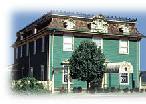
|
Miss Lauras
Any trip into Fort Smith's colorful past should begin at our historic Miss Laura's Visitor Center. Built just before the turn of the century as the city's unique Riverfront Hotel, the ornate building soon became widely-known as "Miss Laura's," the premier bawdyhouse in the rough-and-tumble part of Fort Smith along the Arkansas River.
After legalized prostitution ended in 1924, the building was bought and sold several times and fell into disrepair following the death of the last madam in 1949. A local benefactor, Donald W. Reynolds, purchased the building in 1963 to save it from the wrecking ball. During the mid-1980's, the structure was thoroughly remodeled as an elegant restaurant. In 1992 it became the city's Visitor Center.
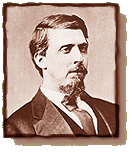
|
Judge Isaac C. Parker
Judge Parker, who for 21 years presided over the Western District of Arkansas and all of Indian Territory, stood for the law west of Fort Smith. Parker's court was largely responsible for bringing civilization to one of the last and wildest frontiers remaining in the American West. But the price of civilization was very costly. In Parker's jurisdiction alone, over 100 deputy United States marshals were killed in the line of duty.
Parker's court was known as one in which there was a certainty of arrest and a surety of punishment. Seventy-nine men discovered this when they were hung from the gallows on the courthouse grounds. Of course Parker faced great criticism from those sympathetic to the criminal and who thought him a cruel man. The debate over capital punishment has changed little in 100 years.
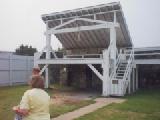
|
The Gallows
Although the original gallows are now gone the re-constucted ones are standing as a reminder to the lawlessness that prevailed during the time. The six nooses are displayed only on special occassions.
Let's cross over the Arkansas river to see some of Van Buren.



|
Van Buren was named after President Martin Van Buren. Over 14,000 people live there.
It is a beautiful town that is rich in history. I spent the first 4 years of my life in Van Buren and I still consider it home.
The Main Street Historic District offers visitors a chance to step back in time. A stroll down Van Buren's beautifully restored Victorian Main Street is a walk through a more gracious and elegant era. The exceptional collection of fascinating shops that line this quaint and picturesque street contain shopping treasures of almost every description.
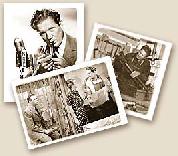
|
Bob Burns
Bob Burns became famous during the 1930's and '40's as the strapping, ruddy-faced comedian who had radio audiences from coast-to-coast bellylaughing at fanciful yarns about his kinfolk and old pals back in Arkansas.
But Burns is probably best remembered for the unique, homemade musical instrument he invented and dubbed the "Bazooka." In fact, because the strange horn was so well known, WWII combat soldiers nicknamed the Army's new shoulder-held rocket launcher the "bazooka," because of its blunderbuss appearance -- just like Burns' popular horn.
Bob plays the "Bazooka"
with Tommy Dorsey~
|


